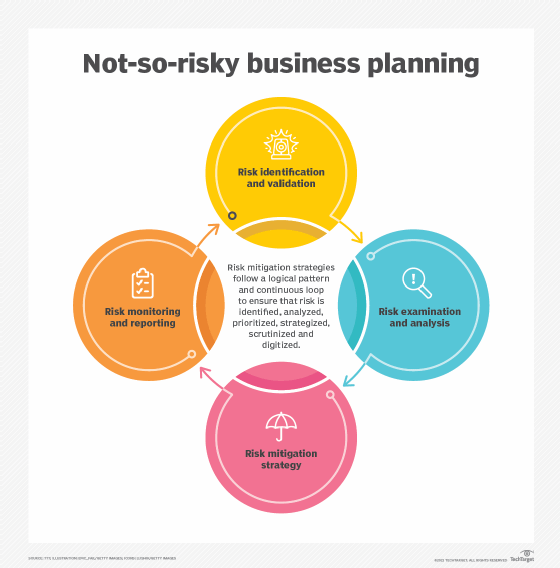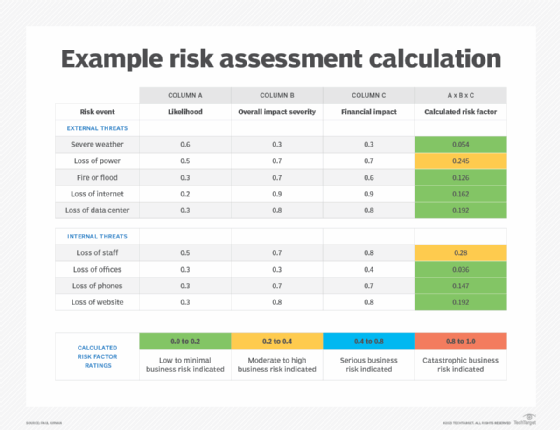Top business continuity risks to plan for and monitor
The key to mitigating business continuity risks is identifying them early. Here are 10 top risks concerning business continuity pros today. Is your organization ready for them?
Business continuity and disaster recovery threats vary by organization, but common threads exist worldwide. Several trends are worth noting and should factor into business continuity and resilience planning for the coming year and beyond.
For the past several years, the Business Continuity Institute, with support from the British Standards Institution and vendors such as Noggin, has published its annual "BCI Horizon Scan Report." This report examines key trends and developments in business continuity. Though some constants remain, the business continuity risks detailed in the report evolve as technological and global developments occur.
In recent years, threats such as cyberattacks, fraud, supply chain disruptions, critical infrastructure outages and data breaches have caused more of a stir than traditional business continuity and disaster recovery (BCDR) threats, such as network disruptions and power outages. Weather-related disasters, while always a concern, continue to increase in frequency as changes to the global climate evolve.
In the 2024 report, the BCI received detailed survey responses from 111 people in 38 countries, representing 14 different business sectors.
While the survey does not fully represent IT pros worldwide, the results remain clear: These risks pose major threats to business continuity, no matter where you are.
What are business continuity risks, and why is it important to identify them?
Business continuity risks, as the name suggests, are disruptions that cause downtime or otherwise threaten an organization's ability to conduct business as usual. Risks come in all forms. Technology-based threats include cyberattacks, infrastructure failure and IT outages. Not all risks come from tech, however. People-based issues, such as global conflicts and the cost of living, can also disrupt operations, causing business continuity to take a hit.
It's critical for organizations to identify the risks they face. The BCI report lists several common risks, but the likelihood and severity of threats vary by business. For example, if an organization is in an area that is not prone to severe weather, BCDR teams probably want to focus more budget and resources on preventing cyberattacks rather than hurricane preparation.
Identifying the risks an organization is more likely to face helps form a strong BCDR strategy that maximizes the budget granted by leadership and builds defenses against the most probable risks. Conduct a risk assessment to get a thorough idea of the threats your organization must prepare for.

10 top business continuity risks
The BCI report details several business continuity risks. The items featured in this article represent a carefully curated selection based on common concerns for BCDR professionals.
The full survey report can be found on the BCI's website. Business continuity and resilience professionals can obtain useful insights from the report, especially when developing future risk assessments and business impact analyses.
Here are 10 of the top business continuity risks IT professionals are concerned about in 2025.
Cybercrime
This category primarily includes cyberattacks, such as ransomware. The report noted the increasingly strong connection between fraud activities and cyberattacks. Ransomware attacks have increased steadily, more so than many other types of cyberattacks. Survey respondents are clearly concerned that, despite their efforts, they are still at risk of cyberattacks. Other major concerns are denial-of-service attacks, phishing and viruses.
Unplanned IT and telecom outages
Despite the improvements in recovery technology and the use of cloud-based systems, the likelihood of damage to critical IT and telecom systems remains a major concern to respondents. Loss of power continues to be the leading cause of IT and telecom outages, while networking problems are the leading cause of service disruptions.
The CrowdStrike outage in 2024, which affected well over 8 million Windows devices, demonstrated the vulnerabilities of critical infrastructures and served as a major wake-up call regarding the deployment of BCDR plans along with robust data backup arrangements.
Cost of living increases
The BCI report cited the strong relationship between supply chains and increases in the cost of living. Continuing increases in business expenses, such as labor costs, hurt many organizations globally. The transportation sector -- for example, airlines and shipping companies -- continues to be hard hit by inflation.
Critical infrastructure failure
Failures within the many elements of critical national infrastructure are a key concern for many professionals. Loss of power, water, gas and sewage removal are among the top concerns, while the national highway, rail, air travel and waterway infrastructures are essential to the vast majority of businesses worldwide. Backup power, such as diesel and natural gas generators, batteries and uninterruptible power systems, is the primary strategy for responding to electric utility outages.
Adverse weather and natural disasters
The frequency of severe storms and natural disasters continues to be a major concern for business continuity professionals. These risks include hurricanes, tornadoes, lightning strikes, high winds, flooding, mudslides and wildfires. Earthquakes can cause enormous damage and are a continuing threat in numerous areas across the U.S. Solar flares and storms can cause large electromagnetic pulses that disrupt electronic equipment.
Supply chain disruptions
Whether an upstream or downstream disruption occurs, damage to an organization's supply chain continues to be a major concern. Supply chain continuity is one of the most important activities a BCDR planning team can address, as it influences an organization in many ways. Even organizations that provide services via the internet and have no manufacturing operations still need a functioning internet to deliver their services.
Acts of terrorism
Active shooter incidents, use of motor vehicles as weapons and detonations of explosive devices continue to capture headlines worldwide. Survey responses showed a continued concern for these events.

Security incidents
Different from cyberattacks, these business continuity risks include physical security breaches, such as unauthorized building access, vandalism to a building and its facilities, fraud and civil disturbances.
Fire
No matter the level of preparation and prevention, fires can and do occur. One of the most important ways respondents can prepare for fires is to have fully charged fire extinguishers in easily accessible locations marked with appropriate signage. Fire detection and suppression systems are typically required by local building codes, as are fire extinguishers.
Transport network disruptions
Once products have been manufactured, the organization depends on many different channels to distribute the finished products, such as rail, motor vehicle transport, air freight and marine-based shipping. If those channels are unavailable, organizations will not be able to fulfill their orders.
Paul Kirvan, FBCI, CISA, is an independent consultant and technical writer with more than 35 years of experience in business continuity, disaster recovery, resilience, cybersecurity, GRC, telecom and technical writing.







